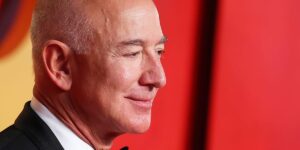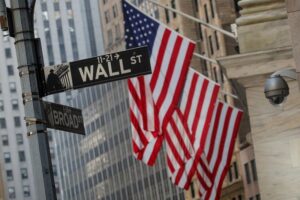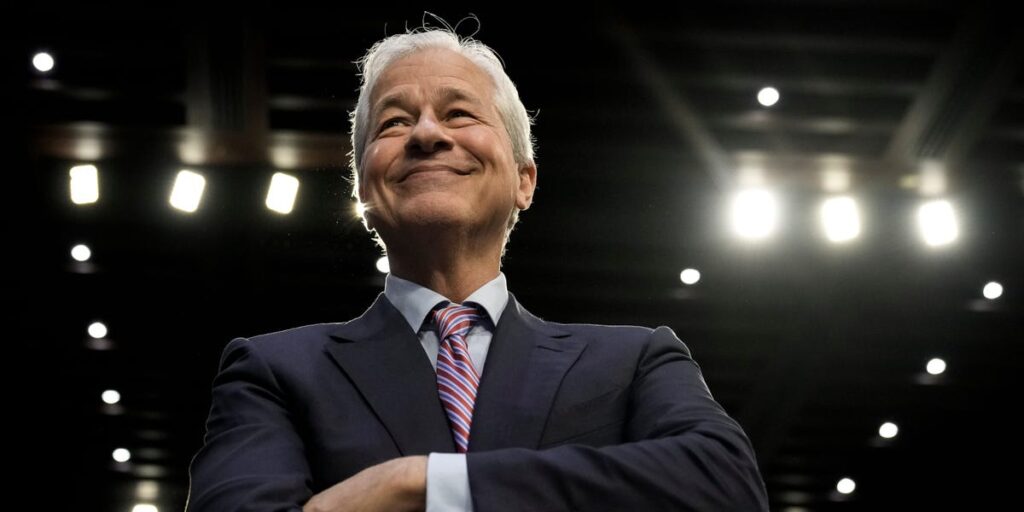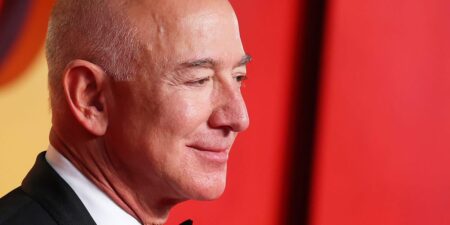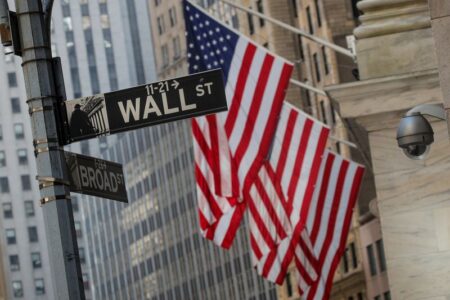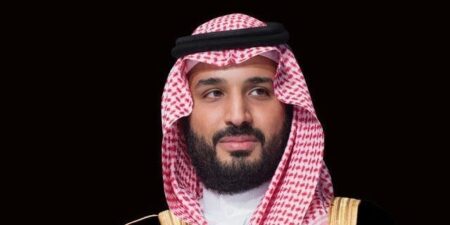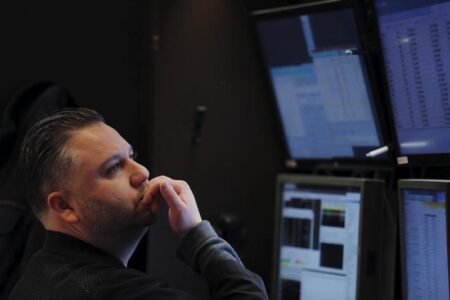Jamie Dimon, the billionaire CEO of JPMorgan Chase, has led the massive finance company for the better part of the last two decades, driving its assets and stock value to new heights.
“In the midst of the most serious and far-reaching financial crisis since the 1930s — much of it caused by plain old avarice and bad judgment — Dimon and JPMorgan Chase stood apart,” Duff McDonald, an author and journalist, wrote of Dimon in his 2009 book “Last Man Standing: The Ascent of Jamie Dimon and JPMorgan Chase,” referring to the 2008 financial crisis.
“Much of the melodramatic coverage of Wall Street postcrisis has focused on its flaws — the hubris and the greed,” McDonald wrote. “Jamie Dimon’s story contains the opposites — the values of clarity, consistency, integrity, and courage. By sticking to them, Dimon has unquestionably become the dominant banking executive of his era.”
Here’s a look at Dimon’s career, from his stint as a management consultant to becoming the billionaire financier propelling JPMorgan Chase’s rise.
Representatives for Dimon declined to comment for this story when contacted by Business Insider.
Born into the world of finance
Dimon was born in New York City on March 13, 1956, one of three sons to Theodore and Themis (née Kalos) Dimon. His father was a stockbroker at Shearson who would eventually become an executive vice president at American Express.
After her sons went to college, Themis Dimon pursued a master’s degree in psychology at Columbia University’s Teachers College and volunteered at a preschool program.
The couple, who were married for 65 years, died within 22 hours of each other, according to their 2016 obituaries.
Dimon graduated from Tufts University, where he majored in psychology and economics. After a stint as a management consultant at Boston Consulting Group, Dimon earned his MBA from Harvard in 1982.
A banking whiz kid from the start
Dimon’s finance skills were clear from early on. At the behest of his mentor, the financier Sandy Weill, he turned down offers from Goldman Sachs and Morgan Stanley to accept a job at American Express after graduating from Harvard.
When Weill left American Express in 1985, Dimon followed. The pair ran Commercial Credit, a company they would build into the financial-services conglomerate Citigroup.
An unexpected ouster led to a key pivot
Weill asked Dimon to resign in 1998 after 15 years of working together. Weill would later tell The New York Times it was because Dimon wanted to take over as CEO but he wasn’t ready to retire. Weill told the Times he regretted that the conflict led to Dimon’s ouster.
On an episode of the “Coffee with The Greats” podcast, Dimon said he was “totally surprised” by his firing from Citigroup. He considered jobs at Amazon and Home Depot but ultimately became CEO of Bank One in 2000, which at the time was the nation’s fifth-largest bank. Eventually, it would merge with JPMorgan.
JPMorgan’s merger with Bank One saw Dimon’s power surge
When JPMorgan merged with Bank One in 2004, Dimon became the new banking giant’s president and chief operating officer. He would later become the bank’s CEO in 2006.
Dimon quickly slashed expenses across the board, McDonald wrote in his biography. He ended the practice of the bank’s corporate wing paying for clients to attend the US Open tennis tournament, canceled a $5 billion contract with IBM for computer-management services, and cut regional managers’ compensation by as much as 50% over the next two years.
“He’s going down like cod liver oil,” Bloomberg reported one banker said of Dimon’s approach.
McDonald wrote in his biography of Dimon that another unnamed banker said, “The news that Jamie is flying in is similar to being told that Ivan the Terrible is coming for tea.”
His demanding leadership has proven valuable over the years
In 2008, Dimon played a key role in rescuing major banks from collapse amid the financial crisis. JPMorgan purchased Bear Stearns for $10 a share and also acquired Washington Mutual, which at the time was the largest US savings and loan institution, The New York Times reported.
“Jamie was demanding. He was relentless,” Theresa Sweeney, his assistant from 1993 to 2000, is quoted as saying in McDonald’s biography. “And he always wanted the one thing I hadn’t done. I’d walk in there with my pad of paper and he’d give me 10 things to do. I’d go back to my desk. An hour later, he’d call me and I’d have already done nine of them. And he’d ask for the tenth. And he pounded and pounded and pounded until you got it done. By the third time he asked for something, you better have been at a funeral, because that was the only acceptable excuse for not having it finished.”
Under his leadership, and due largely to its strategic partnerships and acquisitions, JPMorgan’s value has skyrocketed, becoming the leading American bank in terms of domestic assets, market capitalization, and stock value.
College sweethearts became parents to 3 girls
Dimon married his college sweetheart, Judith Kent, after meeting at Harvard. They have three daughters together: Julia, Laura, and Kara Leigh.
Kent went to Tulane University for her undergraduate degree before receiving a master’s in organization psychology from the Catholic University of America and an MBA from Harvard. She worked alongside Dimon at American Express as a management trainee shortly before they married, a 1983 wedding announcement published in The New York Times said.
Dimon has had a few health scares over the years, including a battle with throat cancer in 2014 and emergency heart surgery in 2020 after he was diagnosed with an aortic tear, The Wall Street Journal reported.
A longtime political donor, Dimon has considered a run for office himself
For many years, Dimon was a prominent donor to the Democratic Party. Though he labeled himself as “barely a Democrat” in 2012, his political ties to the Obama administration led to speculation he would be named secretary of the Treasury. The position was ultimately given to Timothy Geithner.
In 2016, he joined a business-advisory forum assembled by then-President Donald Trump, though it disbanded roughly a year later. Dimon supported several of Trump’s jobs and tax policies but publicly disagreed with him on matters of immigration and international trade.
He briefly considered running for president in 2018. Though he ultimately decided against it, MarketWatch reported that he said, “I thought about thinking about it.”
The billionaire hedge-fund manager Bill Ackman encouraged Dimon to consider a presidential bid in 2023, Forbes reported. The outlet also said Dimon expected to lead JPMorgan for at least 3 ½ more years.
Though he hasn’t made any moves toward a campaign for public office, Dimon told Bloomberg last spring, “I love my country, and maybe one day I’ll serve my country in one capacity or another.”
Dimon’s continued bank-saving has led to record JPMorgan profits
Dimon reprised his role as bank-saver in 2023, The New York Times reported, working as a partner with Treasury Secretary Janet Yellen and the Fed chair Jerome Powell to convince leaders of 11 major banks to pitch in $30 billion to prevent First Republic Bank from collapsing in the wake of Silicon Valley Bank and Signature Bank failing in rapid succession.
In doing so, Dimon was “acting as a senior statesperson who is helping to shore up the financial industry in a time of crisis of confidence,” Mike Mayo, a longtime banking analyst, said to the Times. “With that comes potentially higher prestige but also potential backlash.”
But so far, the backlash hasn’t come.
Per Fortune, JPMorgan’s stock value has tripled since Dimon became CEO, and Bloomberg reported that in 2023, the bank recorded the largest-ever annual profit among US banks, pulling in nearly $50 billion.
Dimon may be retiring sooner than expected
During a Q&A with investors on Monday, Dimon suggested his retirement may be on the horizon.
While in the past Dimon joked he would retire in five years, when asked about his succession plan this time the 68-year-old said the timeline was “not five years anymore.”
The longest-running CEO on Wall Street also said the plan to identify his replacement was “well on its way,” and that he could potentially stay on as chair.
Note: This story was originally published April 2024 and has since been updated.
Correction: April 9, 2024 — An earlier version of this story misstated the name of the bank JPMorgan merged with in 2004. It’s Bank One, not One Bank.
Read the full article here




